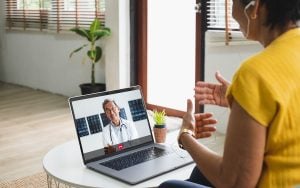Have you tried using Telehealth?
Telehealth services are convenient and easy to use
 David Wetherhold, MD
David Wetherhold, MDChief Medical Information Officer
Scripps Health
Taking advantage of virtual care services to manage your health care can be a good option. Also known as telehealth or telemedicine, virtual care is widely available.

Virtual care visits are similar to in-person visits with your doctor or another member of your health care team.
These online visits and options have many advantages, especially if you are looking to save time or prefer to stay home if possible to avoid any potential exposure to viruses and other contagious conditions.
At Scripps, several telehealth options are available for patients, from wellness and follow-up visits to consultations and on-demand acute care visits. All you need is a MyScripps account and a mobile phone, tablet or computer.
What is telehealth?
The term telemedicine, or telehealth, refers to the use of telecommunications technology — such as mobile health apps and video conferencing — to quickly connect patients with health care providers or services. For example, you might use an app on your smart phone to have a real-time video visit with a provider or answer a few questions to get a diagnosis and treatment plan via email — all from the comfort of your own home or another convenient location.
“Telehealth options have expanded significantly due to the pandemic, making it safe, efficient and easy for patients to get the care they need when and where it is most convenient,” says David Wetherhold, MD, chief medical information officer for ambulatory care at Scripps Health.
“Anything where the provider can assess quick visual cues and can access relevant vital signs or other information online is a good fit for virtual care,” Dr. Wetherhold says. “Patients are connected with their provider in a seamless, time-friendly manner and receive the same high level of care and attention they would in an in-person visit.”
Patients may be surprised at how many conditions or symptoms can be treated using virtual care. However, not every medical condition is best addressed remotely. Always call 9-1-1 or head to the nearest emergency room if you have severe or life-threatening symptoms like chest pain or shortness of breath.
How telehealth works
Telemedicine encompasses a broad range of virtual visits, usually through a secure online patient portal, such as MyScripps. In addition to virtual care visits, patient portals allow you to safely communicate with your doctor and health care team, schedule appointments, request prescription refills, review test and lab results, and receive visit summaries.
Several virtual care services and virtual visits are available through Scripps and are accessed through the MyScripps patient portal, including:
1. Video Visit
Video Visits are online office visits in real-time, basically a virtual doctor visit. You talk to a Scripps doctor, nurse practitioner or physician assistant via video instead of visiting the office to receive the care you need. These visits may be with your primary care doctor, a specialist such as a cardiologist or oncologist, or a HealthExpress provider.
Video visits are good for the diagnosis and treatment of a variety of illnesses and minor injuries, such as:
• Allergies
• Asthma
• Colds and flu
• Minor lower back pain
• Skin Conditions
• Sprains and strains
Consultations, post-surgical visits and visit follow-ups are also well-suited for video visits. In some instances, you can have your annual physical, establish care as a new patient or manage a chronic condition via a video visit.
2. E-Visits
E-visits are a very convenient way to address a minor illness. The process involves an online health questionnaire through the patient portal. Once you answer questions about your symptoms (and possibly attach images) a health care provider reviews your information and replies with a written care plan.
At Scripps, a variety of conditions can be treated with an e-visit, including colds and flu, pink eye, female urinary tract infections and female yeast infections among others. If a provider is unable to diagnosis your condition or recommends a different type of visit for your condition or symptoms, they will respond with instructions on where to be treated.
3. Symptom Checker
Symptom Checker is an online triage tool to assess your symptoms and recommend the most appropriate type of care — including COVID-19. When you’re unsure whether you should see a provider, this helps you decide whether to seek care now or later, in person or online. Simply answer some questions about your symptoms and get recommendations on when and where to receive care. Home care suggestions may also be provided, if appropriate.
How to use telehealth services
Making use of telemedicine services is usually simple with your mobile phone, tablet, laptop or desktop computer. Patients usually request a visit by submitting basic information on their condition, and then the provider accepts or declines the visit, or schedules it for the future.
It can be helpful to have home monitoring devices, such as a blood pressure cuff or a blood glucose monitor, to transmit information to your doctor or another member of your health care team if necessary. Some wearable devices can automatically record and transmit information directly, such as heart rate and physical activity, that are important for monitoring chronic conditions or diagnosing new symptoms.
At Scripps, accessing virtual online care starts with your MyScripps account. Log in to your account to:
• Schedule telemedicine visit
• Request an on-demand video visit with HealthExpress
• Submit an e-visit questionnaire
• Complete e-check in for your visit
• Log in to complete your video visit
To learn more, visit www.scripps.org
